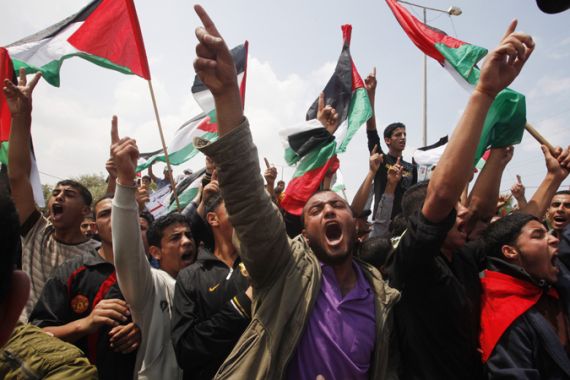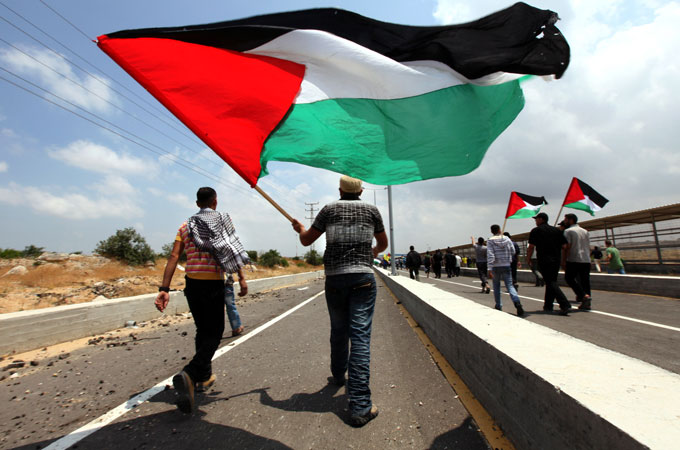Palestinian activism energised by Arab Spring
Palestinian activists adapt tactics from uprisings to their own struggle, as tide of Pan-Arabism brings popular support.

 |
| Palestinian factions have united during recent protests to demand the right of return for refugees [EPA] |
Beirut, Lebanon – Palestinian activists are looking to the Arab Spring to bring new energy and methods to their own struggle against Zionism.
Generations of Palestinian refugees living in squalid camps in Lebanon, Syria and Jordan have been paying close attention as their fellow Arabs have risen up against corrupt and oppressive leaders, as have those living in Gaza, the West Bank and Israel.
Then, on May 15, Palestinians launched their own movement with a symbolic enactment of the return to Palestine.
The events’ organisers chose to emphasise collective action, rather than the collective sorrow that has tended to mark the date in previous years.
“For the first time, we saw all the Palestinian factions united under one slogan: return to Palestine and carrying the same flag, that of Palestine,” a Palestinian activist who goes by the pseudonym of Abu Omar says.
“The old, the young, men, women and children, were all there, sharing the same ambition. I’ve never seen such a unification, neither have those older than me, I believe.
“Everyone put their political allegiances aside and focused on their allegiance to Palestine.”
The Return To Palestine March Committee has representatives from Hamas, Fatah, the Popular Front for the Liberation of Palestine, and various other factions, along with many independents.
In a symbolic reversal of the flow of people forced to flee Zionist violence in 1948, as many as 40,000 people gathered in the southern Lebanese town in Maroun al-Ras, which lies within walking distance of the boundary with Israel.
The majority of the protesters travelled by bus from camps across the country, and were joined by Lebanese nationals and foreigners.
Similar protests were held the same day in Gaza and the West Bank. In Syria, protesters managed to break through the fence near the Druze town of Majdal Shams.
Israeli soldiers responded to the civilian protests with lethal force, just as security forces have done recently in Tunisia, Libya, Bahrain and Syria. Thirteen protesters in Lebanon and Syria were killed by Israeli fire on May 15.
The second protest action of the “return to Palestine” campaign was less successful. Organisers agreed to postpone a march that they had planned to mark the “Naksa” anniversary, after the Lebanese army refused to allow protesters to travel to the border area, declaring it a closed military zone.
Naksa Day marks the beginning Israel’s occupation of the West Bank, Gaza, East Jerusalem and the Golan Heights when it won the Six-Day War on June 5, 1967.
Israel pressured Lebanon’s fragile interim government not to allow Sunday’s protest to go ahead, as did the US and several European countries.
Seeking to maintain good relations with the Lebanese authorities, and to avoid more deaths, the organising committee agreed to call off the march.
Vida Warde, a Palestinian activist and a member of the committee, said that they had agreed to call off the march entirely because the activists want to keep up the momentum of the May 15 protest, rather than settle for scattered splinter demonstrations.
“We could have protested but it wouldn’t have been the same as May 15,” she says, adding that the committee respected the decision made by Lebanese authorities regarding Sunday’s protest.
Warde vowed that the march had only been postponed and that there would be an ongoing campaign of large-scale actions, in coordination with activists in Jordan, Syria, Egypt, Jerusalem and the Palestinian Territories.
The Arab Spring has paved the way for activists elsewhere in the Arab world to turn their efforts to the Palestinian Cause, she said, especially in Egypt.
“Palestine has always been the Revolution,” she said.
Despite the committee’s position, some small independent groups attempted to protest at the Lebanese border. The Lebanese army stopped a group of 20 youths who made it to the border town of Kfar Kila.
Syrian state television reported that 23 Palestinian and Syrian protesters had been killed in the Golan Heights on Sunday, a death toll which Israel disputes.
Yet Navi Pillay, the UN human rights chief, condemned Israeli security forces for their “excessive use of force” in the Golan Heights, saying they have killed as many as 40 demonstrators in the area in recent weeks.
“However difficult the circumstances, the use of live ammunition against allegedly unarmed protestors, resulting in large numbers of deaths and injuries, inevitably raises the question of unnecessary and excessive use of force,” the UN High Commissioner for Human Rights said on Tuesday.
Binyamin Netanyahu, the Israeli prime minister, blamed Syria for allegedly allowing two border protests to go ahead.
There was also violence on the Israeli side of the border in Majdal Shams on Sunday evening, as Druze and Palestinians youths clashed with Israeli security forces. Casualties were reported too in the West Bank refugee camp Palestinian refugee camp of Qalandia.
The US state department issued a statement calling for “all sides to exercise restraint”, condemning what it termed a “provocative” action by the protesters and stressing Israel’s “right to defend itself”.
On Monday, Hassan Nasrallah, the leader of the Lebanon’s Hezbollah movement, praised the Naksa protesters on the Golan Heights and rebuked the US’s position on the protests.
“What happened yesterday on the anniversary of the Naksa on the Golan Heights reveals that the US administration wants to hijack the Arab revolutions,” he said at the opening of a convention on the Iranian supreme leader, Ayatollah Ali Khamenei.
“What happened also demonstrates Washington’s absolute commitment to Israel’s security.
“This is Washington which talks about human rights and freedoms,” Nasrallah added.
Subversive use of social media
Though the Naksa march did not take place as they had originally planned, Palestinian rights activists in Lebanon argue that they scored a tactical victory against the Israeli security apparatus through their innovative use of social media.
Because their communities are closely-knit, activists have been able to rely on direct human contact in a way that protesters in Egypt and Tunisia could not. They are also distrust online communications, given that so many high-profile activists suspect that their email and Facebook accounts are monitored.
Instead, several sources confirmed, activists involved in the return to Palestine campaign deliberately spread disinformation via Facebook to encourage Israel to invest vast resources in preparation for acts of protests that never would have taken place, with or without the military ban.
Some Facebook pages were entirely fictional, with those involved in the campaign warned in advance.
“People have gotten into the game,” says one committee member, who asked not to be identified, explaining that many people posted “outlandish comments that induce a reaction on the Israeli side”.
One line of comments, for instance, discussed a fictional plan to fly hot air balloons over the Lebanese border.
(Jitters about possible incursions into northern Israel led air controllers in Haifa to deploy warplanes and helicopters after they mistook stars for “enemy aircraft” on the eve of the Nakba protests, according to the Israeli military’s weekly magazine.)
Having been caught off-guard by the Nakba Day protests, Israel over-prepared for the Naksa anniversary, the activist says.
Indeed, comments Netanyahu made the day before Naksa Day confirm the high state of alert provoked by the possibility of border protests.
“There are extremist elements around us who are trying to break through our borders and threaten our community and our citizens. We will not allow them to do so,” Netanyahu told the Israeli cabinet.
Additional soldiers and military vehicles were sent to patrol the border, and barbed wire, trenches and other fortifications were set up along the “frontline”.
Snipers lay ready for the unarmed protesters, and significant reserve forces were ready for deployment.
Al-Karama for Palestinians
Rooting their movement in the spirit of grassroots empowerment that has characterised the Arab Spring, Palestinians have chosen to focus on a single issue, which activists say is non-negotiable.
They demand the return to Palestine of the hundreds of thousands of people who were forced from their homeland in the ethnic cleansing that took place with the creation of the state of Israel in 1948.
The latest protests are an extension of a decades-long struggle to exercise that right, a right that has been backed by numerous United Nations resolutions.
What is different with the movement that began on May 15 is the level of co-ordination, and the resulting clarity of the protesters’ message.
It is a rallying point that has achieved the exceptional feat of drawing support from across political and religious lines. Overwhelmingly, protesters were willing to caste aside their political alliances and unite under the Palestinian flag.
On May 15, people chanted, “The people want to return to Palestine,” recalling the chant that rang on avenue Habib Bourguiba and in Tahrir Square earlier in the year, “The people want to overthrow the regime”.
Palestinians living in the camps share a desire for al-Karama, or dignity, with protesters elsewhere in the Arab world, Abu Omar says, though the underlying causes of their disempowerment are starkly different.
The limbo which began for so many Palestinians when they were uprooted from their homeland with the creation of Israel has left them with few economic, social, political or civic rights, he says.
The Burj al-Barajneh camp in Beirut where the activist lives with his family offers a snapshot of these conditions: 20,000 people live in a single square kilometre of crumbling, overcrowded buildings, with scant opportunity of a better life.
“There are four generations here and the population is increasing. The right to Lebanese nationality or to own land is unattainable,” he explains.
The inspiration for the May 15 march on the southern Lebanese border came directly from the Tunisian and Egyptian uprisings, Abu Omar says.
Young Palestinians, invigorated by what they had seen of uprisings elsewhere, have thrown their support behind the movement.
“Tunisia and the other uprisings demonstrated that a people can demand their rights, peacefully,” he says.
“The young, who were lost, are now asserting their right to return. We are working on an action plan until the return.”
Pan-Arabism revived
Aside from the backing of the various Palestinian political factions, the return to Palestine movement has drawn strength from the grassroots Pan-Arabism that has resurged as the Arab Spring spreads across the region.
All activists interviewed were adamant that the Nakba Day march would not have been possible if Hezbollah had not given the protest its explicit blessing.
The May 15 protest would not have been possible, they say, if the political party had not negotiated with the Lebanese army for protesters to be allowed to travel unhindered to Maroun al-Ras.
Hezbollah also offered some financial support to the protesters, helping to finance the buses that transported refugees from the camps to the border.
This explicit backing of the Palestinian protesters is all the more significant given the historic tensions that have hindered relations between Palestinian refugees and Lebanese Shia population.
In Egypt, the opening of the Rafah border crossing has the potential to allow Egyptian nationals a means to protest in solidarity with the inhabitants of Gaza – depending on how free Egyptians will be to travel to Gaza in practice.
The movement has also found backing amongst Lebanese civil society, keen to get involved in the Arab Spring.
Members of a pan-Arab nationalist youth group in the seaside city of Saida told Al Jazeera that justice for the Palestinian people was a central concern for their group, and one that brought Arabs together across religious or sectarian lines.
“May 15 renewed the soul of the people,” Hussein Shukar, a member of the group, says.
“Our view is that that the Arab nation can only be strong and that we will only be able to control our own resources and our occupied land if we all unite together.”
Follow Yasmine Ryan on Twitter @yasmineryan